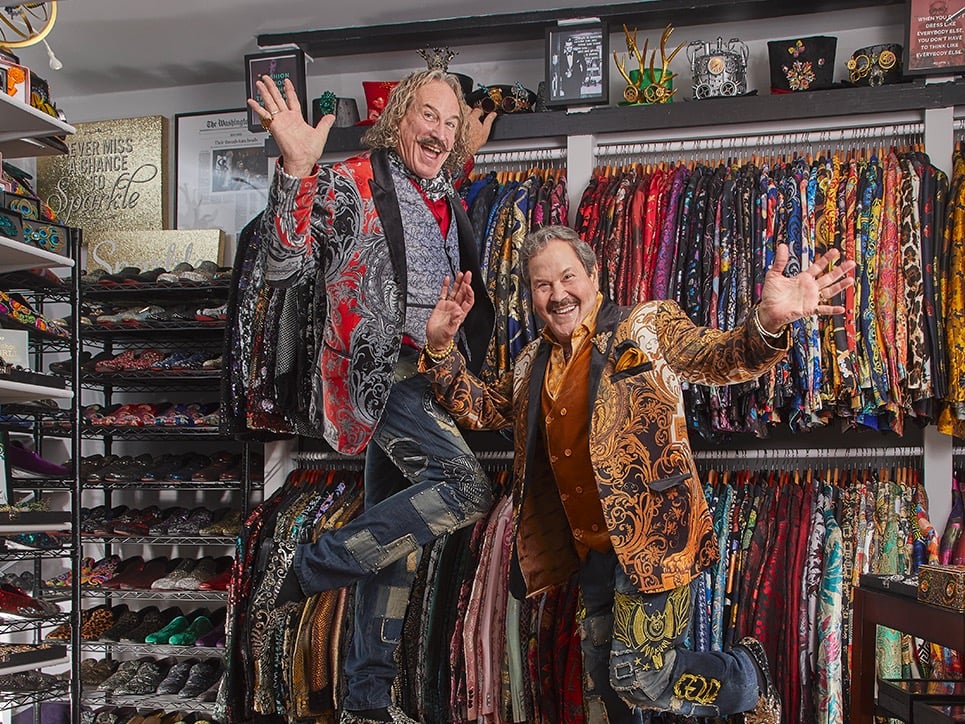Have you ever gone to a production of HAMLET, heard the tortured hero cry, "O! That this too, too solid flesh would melt," and wanted to shout, "Amen, brother!"
Maybe you've dieted, worked out, lost weight, but still have stubborn bulges–"saddle bags" on outer hips and thighs, "love handles" slopping over your belt, chubby knees, multiple chins, protruding tummy.
It is small comfort, but you can blame your parents, says Dr. Franklin Richards, a local plastic surgeon. He says heredity dictates the location of persistent fat-storing areas.
The bad news is that these pockets of fat often defy diet and exercise. The good news is that these are the areas that respond best to liposuction.
Liposuction, also called lipoplasty or body sculpture, is the nation's most popular cosmetic surgical procedure.
The procedure seems simple. The physician first makes a tiny–usually less than a quarter of an inch–incision in the area to be liposuctioned. Then a small, hollow tube called a cannula is inserted under the skin. The cannula is attached to a vacuum-pressure unit, enabling the doctor to vacuum out excess fat.
Most practitioners do "tumescent" liposuction, injecting a solution of painkilling lidocaine and saline into the tissue before suction. The solution loosens fat, making the process less traumatic than nontumescent or "dry" liposuction.
Tumescent liposuction is "the gold standard," according to Richards. It may be enhanced with ultrasound to dislodge dense, fibrous fat–often found on men's chests and backs. The use of ultrasound also reduces bruising–but it increases the risk of burning in unskilled hands.
Power-assisted liposuction is the newest variation. PAL's motor-driven, rotating cannula reduces bruising and shortens the time needed to remove fat. PAL is less taxing for the doctor, but it lessens control over the cannula.
Because the incisions are tiny and patients aren't hospitalized overnight, many patients don't realize the seriousness of liposuction. It is surgery, and it is not a minor procedure.
Publisher Bill Regardie admits he had no idea what he was in for when he chose to have his "love handles" and belly fat suctioned away several years ago. "I take a lot of vacation, I spend a lot of time in a bathing suit, so I took the easy way out," he says.
Regardie showed up on a Monday morning at Georgetown University Hospital. Surgeon Scott Spear marked Regardie's waist and abdomen with red lines defining the areas for fat removal. Spear and Regardie had agreed to remove the maximum considered safe–just under 5,000 cubic centimeters, or 1.3 liters of fat. Then Regardie was sedated.
When he woke up, he was in a reclining chair in the recovery area. He slept at home for most of that day and night, awakening the next morning in severe pain.
Three days later he went back to Georgetown to be checked. Spear's office was at the end of a long corridor. Regardie still remembers that excruciating walk.
"I thought, 'procedure,' " he says. "I didn't know that to get the fat out they'd have to literally shave it off the sides of my stomach."
Several years later and several inches smaller around the middle, Regardie is pleased with the results. "I'd have had to do 2H million sit-ups" to get this result, he says. "But I remember those first three or four days."
"DON'T BUY ANY NEW CLOTHES"
Recovery from liposuction can take days, weeks, or months, depending on the extent of the procedure and an individual's rate of recuperation.
When patients leave the hospital or doctor's office, they have bandages covering their incisions. Often there are stitches that will be removed a few days later.
Patients wear elastic "constriction garments" for about a month after surgery to reduce the swelling, smooth the treated area, and reduce bruising. One lipo veteran advises having the surgery well before Washington's summer months, when the tight garments can be uncomfortable.
Liposuction doesn't produce instant benefits. Though bruises fade in two to three weeks, the swelling may not disappear completely for months, according to DC cosmetic surgeon Steven Hopping. Some patients also experience persistent numbness in the treated areas.
Washington prices for liposuction, including fees for the surgeon and anesthesiologist, can range from about $1,900 to do knees up to $5,000 for abdomen and hips (or flanks in men) and $8,000 for the works–abdomen, hips/flanks, knees, and inner and outer thighs.
How big a difference can liposuction make? Satisfied patients say that when their bodies were reshaped, their self-confidence skyrocketed.
Sandra, an executive assistant in her late twenties, had her saddle bags liposuctioned a few years ago. Before the surgery, her doctor told her, "You'll notice a difference right away, but don't buy new clothes." He could not guarantee exactly how many inches she would lose.
Sandra had the surgery on a Thursday and was back at work the following Monday. Her recovery was painless: "I was a little stiff. I've also had breast augmentation, and that was horribly painful."
For Sandra, going down one pants size improved her self-esteem. "I feel happy when I put on a pair of jeans," she says.
THE GIFT THAT KEEPS GIVING
Ann, a mortgage banker, gave herself the gift of liposuction as a post-divorce treat. She had her inner and outer thighs and her buttocks done in 1997.
"Did it hurt? Like crazy for the first day, and after that it was sore, but nothing a great workout doesn't give you," Ann recalls. "Would I do it again? In a heartbeat. I felt better about myself."
Ann plans to have liposuction done on her upper back and her knees.
Joe, a marketing executive in his early thirties, had liposuction four years ago. Joe had been a skinny kid, but after college his waistline ballooned, and he developed saggy breasts. "I'd lie in the sun with a T-shirt on," he recalls.
Hopping did liposuction on Joe's spare tire and his chest. Joe's waist dropped from 36 inches to 32. His chest regained its manly shape. His ego got a major boost, too. Now he works out with a trainer three days a week.
"I SAW MY HUSBAND CRYING ON 60 MINUTES"
Many patients, underestimating the seriousness of liposuction, do less research than they would about other surgery. Other patients are intimidated by physicians and find it difficult to ask hard questions.
Linda consulted three plastic surgeons before selecting one to do liposuction on her hips, thighs, abdomen, and buttocks. The first two gave her conflicting advice on the amount of fat they would remove. So she sought a third opinion.
The surgeon who took the middle ground was the only one who recommended using ultrasound. When Linda questioned his approach, he told her that she shouldn't be telling him how to do his job.
Linda disliked his attitude, but she felt most comfortable with the amount of fat he promised to remove–eight to ten pounds.
When Linda emerged from surgery, she felt fine. But about an hour after returning home from the doctor's surgical facility in Chevy Chase, Linda started urinating blood. As the day wore on, the bleeding increased.
Linda began to panic. "I could see my husband crying on 60 Minutes," she says.
Her husband took her to an emergency room. She was hospitalized for two days.
Although her doctor denies that the bleeding had any connection to the surgery, Linda is convinced her bladder was "blasted" by the ultrasound. She also believes he removed less fat than promised, but her surgeon won't discuss the case with her.
"I'D GO TO THE HOSPITAL"
Stacy, a defense analyst in her late forties, asked someone at her gym for a recommendation. The woman she asked turned out to be a surgeon's nurse.
"My abs were already tight," Stacy says. But her stomach "pooched out." The surgeon told her that with liposuction and a mini tummy tuck she would go down a size and have a flat stomach.
Because she was so fit, the doctor predicted she would be back at work in two or three days. Stacy had a choice–to have the surgery in a hospital or in the doctor's office. He advised her to do it in his office with a local anesthetic. "He thought it was not a big deal, it would not be very painful, and the recovery would be easier," she says.
The surgeon gave Stacy a local anesthetic, but it did not numb her enough. During the liposuction, Stacy was in pain–her husband heard her cries in the waiting room.
With no anesthesiologist present, the surgeon could not provide additional relief.
"I didn't realize how much it was going to hurt–both during the procedure and afterward," Stacy says. "If I had it to do over again, I would definitely go to the hospital and have stronger anesthesia."
The recovery was more painful and prolonged than Stacy had anticipated. For more than a week she took pain medication around the clock. After that she was able to return to work, but only part-time for another week. She wore her constriction girdle for two months; the swelling did not go down until four months after surgery.
Though Stacy did not lose a full size, her clothes fit better. She was satisfied with the result–but her doctor wasn't. "I don't want anyone looking at your stomach this way and knowing I did it," she says he told her. He insisted on doing a "touchup" at no charge to get rid of some dimpling and a slight ridge where the fat came out unevenly.
The additional liposuction was almost as painful. She can't see much difference.
Stacy's surgery cost her $4,300. Would she do it again? Never.
"I'm still storing fat; I'm just storing it in other places where I never had fat before," Stacy says. Her stomach is flat, but when she gains a few pounds, her back gets fat.
"Guess the fat has to go somewhere," she says.
Bill Regardie has also noticed a weight shift. Weight gains show up on his chest instead of his midsection.
ASKING THE RIGHT QUESTIONS
There is no such thing as risk-free, pain-free surgery with guaranteed results. Could much of Stacy's pain and disappointment have been prevented if she had asked more questions beforehand?
Here's what is helpful to know.
What are the doctor's credentials?
any doctor with a medical license and the needed equipment can perform liposuction. There are physicians whose training consists of a weekend course taught by the company that makes the device.
The process was invented in 1981 by Yves-Gerard Illouz, a French gynecologist. He realized that the same surgical vacuum used for some gynecological procedures could also remove excess fat.
When Illouz introduced his method, plastic surgeons were skeptical. As a result, many of the doctors Illouz trained were gynecologists and doctors in other specialties.
Liposuction is now part of the repertoire of most plastic and cosmetic surgeons. Liposuction should be performed by a board-certified plastic or cosmetic surgeon, preferably one who performs the procedure frequently.
Ask about the credentials of other medical personnel who will be treating you. Some surgeons perform liposuction with a board-certified anesthesiologist.
You should also talk to a few of a doctor's former patients, asking about their recovery and results.
Where will the procedure be done?
many physicians have in-office surgical suites. There is talk of requiring state accreditation of these facilities, but only California, Georgia, New Jersey, and Texas do it now. Medicare does inspect and accredit surgical facilities, so it's worth asking if a surgeon has this approval.
There is nothing inherently risky about surgery under these conditions. Many patients prefer to avoid hospitals, where the risk of infection may be greater. Ask what emergency equipment is on hand, whether the doctor has hospital privileges should an emergency arise, and what arrangements are in place to transport you there.
Are you a good candidate?
the ideal candidate is in good health, at close to normal weight, and has good skin tone. Liposuction does stimulate some skin contraction, but a person with loose, floppy skin will not get a good result. Liposuction has no effect on cellulite.
Beware any surgeon who offers liposuction for weight control. Removal of too much fat–and the accompanying blood loss–accounts for many of the serious injuries and deaths that have been reported.
Some doctors won't do liposuction on yo-yo dieters whose weight fluctuates.
Do you have realistic expectations?
liposuction will reduce pockets of fat. However, no doctor can tell in advance how many pounds or inches you will lose.
After surgery, your body will seem more proportional, particularly if the rest of you was slim and toned already. But patients have to realize, Hopping says, that "God doesn't make perfect bodies, and neither do plastic surgeons." *


















